
Chain Surveying & Levelling
Chain
Surveying & Levelling
Chain Surveying
- It
is the simplest and oldest form of land surveying of an area using linear
measurements only.
- It
can be defined as the process of taking direct measurement, although not
necessarily with a chain.
Types of equipment
used in Chain Surveying
These equipments can be divided into three, namely
- Those
used for linear measurement. (Chain, steel band, linear tape)
- Those
used for slope angle measurement and for measuring right angle (Eg.
Abney level, clinometer, cross-staff, optical squares) - Other
items (Ranging rods or poles, arrows, pegs etc).
1. Chain: This is an instrument
used for measuring distance. There are four types of chains.
(i) Metric chain: In metric system the chains
of 20m and 30m are commonly used. The chain
is made with galvanized steel wire of 4mm diameter. Each meter is divided into
5 links of 20mm length. It is provided with brass handles on either ends. The
tallies are fixed at every 5m length and small brass rings are provided at
every meter length.
(ii) Engineer’s chain: The Engineer’s chain
is 100ft length and made of 100 links.
(iii) Gunter chain: It is 66 feet long and has
100 links. It is useful for measuring the distance in miles and areas in acres.
10 square Gunter chain = 1 acre = 4840 sq. yards.
(iv) Revenue chain: This chain is of 33ft length
and is divided into 16 links.
2. Tape: The tapes are
divided according to the materials used as following (i) Metallic tapes (ii)
Steel tapes (iii) Invar tapes
(i) Metallic tapes: This tape is made with
waterproof linen with brass, copper wires to avoid stretching. The tapes
available in lengths 2, 5, 10, 20 and 30m.
(ii) Steel tapes: This is most accurate tape for
taking measurements. If carelessly handled it gets broken.
(iii) Invar tapes: If the measurements are to be
made with the highest precision this tape is used. These are 6mm wide and
available in lengths of 30, 50 and 100m.
3. Ranging rods: These are wooden or
metal poles 2m or 3m long and having a diameter of 30mm. They are provided with
iron shoes at the lower ends to facilitate easy driving in the ground. They are
painted in bands alternatively in black and white or red and white. Ranging
rods used for ranging a line.
4. Offset rods: This is
mainly used to measure offsets of shorter lengths. It is usually 2m long.
5. Cross staff: Cross staff
is an instrument used for setting perpendicular offsets. These are three types.
(i) Open cross staff: It consists of 4 metal arms at right angles to each other
having eye vane at two adjacent ends and object vane at the other ends.
(ii) Adjustable cross staff: With this cross staff the object can be set at any
angle.
(iii) French cross staff: This cross-staff is an octagonal brass tube with
slits on its eight faces. With this cross staff we can set the object at an
angle of 450 also.
6. Optical Square: This is an
instrument used for setting out right angles to the chain lines and to find out
the foot of the perpendicular on the chain line from an object. It works on the
principle of reflection.
7. Arrows: These are used for
marking the ends of a chain during the process of chaining. These are steel
pins 400mm long and are pointed at one end.
8. Plumb bob: It is used to
define the vertical line while measuring distance along slopes.
General Procedure in
making a Chain Survey
1. Reconnaissance: Walk over the area
to be surveyed and note the general layout, the position of features and the
shape of the area.
2. Choice of Stations: Decide upon the framework to be used and drive in
the station pegs to mark the stations selected.
3. Station Marking: Station marks, where possible should be tied - into
a permanent object so that they may be easily replaced if moved or easily found
during the survey. In soft ground, wooden pegs may be used while rails may be
used on roads or hard surfaces.
4. Witnessing: This consists of making a sketch of the immediate area
around the station showing existing permanent features, the position of the
stations and its description and designation. Measurements are then made from
at least three surrounding features to the station point and recorded on the
sketch. The aim of witnessing is to relocate a station again at much later date
even by others after a long interval.
5. Offsetting:- Offsets are usually taken perpendicular to chain lines
in order to dodge obstacles on the chain line.
6. Sketching the layout on the last page of the chain book,
together with the date and the name of the surveyor, the longest line of the
survey is usually taken as the baseline and is measured first.
Linear Measurements
Tape Corrections
(a) Correction due to standardization
or (correction due to absolute length)
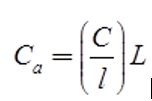
where, Ca = Correction for absolute length
L = Measured length of the line
l = Designated length of the tape
C = Correction per tape length
(b) Correction due to temperature
CT =
Lα(Tm – T0)
where, Tm = Temp. at the time of measurement
T0 = Temp. at the time of standardization of
the tape
α = Coeff. of thermal expansion
L = Measured length
(c) Correction for pull or tension


where, Cp = correction for pull
Pm = pull applied at the time of measurement
P0 = Pull applied at the time of
standardization
L = Measured length
A = Cross-sectional area
E = Young’s modulus of tape
(d) Sag Correction


where, Pm = Pull applied, W = Total weight
of tap = wl
w = Weight per meter length, l = length of tape
- Case:
Normal Tension
At a particular value of pull (where Pm >
P0) pull correction and sag correction neutralize each other. This
value is called normal tension.

(e) Correction due to slope

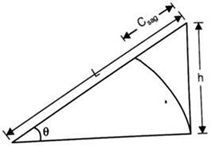
where,
h = difference in elevation between the ends
L = Inclined length measured
l = Horizontal length
Cs = Correction due to sag
(f) Correction due to the wrong alignment

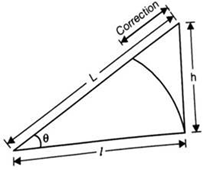
where, L = length measured along wrong alignment
l = Correct length
h = Error in alignment
Limiting Length of
Offset
(a) Effect of error in laying out
direction only

where, l = Limiting length of offset
S = Scale (1 cm = S meter)
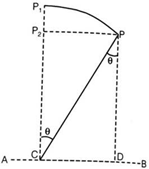
(b) Combined error in length and
direction

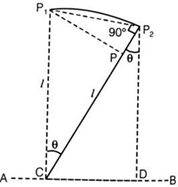
where,
X = error in length measurement.
S = Scale (1 cm = S meter)
Levelling
Definitions
(i) Reduced level: The elevation of a
point with respect to either Mean Sea Level (MSL) or with respect to a fixed
point of known height is called reduced level.
(ii) Benchmark: Benchmark is the
relatively permanent point of reference whose elevation with respect to some
assumed datum is known. It is used either as a starting point for leveling or
as a point upon which to close as a check.
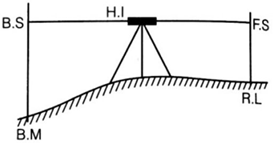
(iii) Back sight: After setting up the
instrument Ist reading taken is called back sight. It is also
known as plus sight.
(iv) Foresight: Last reading taken
from an instrument station is called fore sight. It is also known as minus
sight.
(v) Intermediate sight: All readings other
than back sight and fore sight are intermediate sight.
(vi) Height of instrument: It is the Reduced
Level (RL) of line of sight of the instrument set up at different stations.
H.I = R.L + B.S
R.L = H.I – F.S
Arithmetic Check
(i) For rise and fall method
∑B.S - ∑F.S
= ∑Rise - ∑Fall = Last R.L – First R.L
(ii) Height of instrument method
∑ B.S - ∑ F.S
= Last R.L – First R.L
Reciprocal Levelling
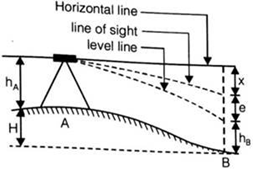
Here, X = error due to inclined line of sight, and
e = error due to curvature and refraction

When instrument is set up at A
Reading on staff at A
= hA
Reading on staff at B
= hB
When instrument is set up at B
Reading on staff at A
= h’A
Reading on staff at B
= h’B
hA – hB =
h’A – h’B If instrument is correct.

Here ‘H’ is the true difference of R.L between A and B.
True Readings

Curvature Correction (CC)
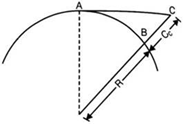
Here, d = horizontal distance between A and B
R = radius of earth
If R = 6370 km
Than CC = -0.07849d2
here ‘CC’ is in meter and ‘d’ is in kilometer

Refraction Correction (CR)
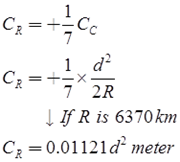
Here d is in kilometer.
Combined Correction Due to Curvature
and Refraction (C)

C = -0.06728d2 meter Here d is in
kilometer.
Contours: Contour is an
imaginary line joining points of equal elevation on earth surface.
Contour interval: Vertical distance between two contour is called contour internal.


No comments added yet!